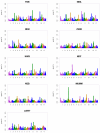Genome Selection and Genome-Wide Association Analyses for Litter Size Traits in Large White Pigs
- PMID: 40564276
- PMCID: PMC12189426
- DOI: 10.3390/ani15121724
Genome Selection and Genome-Wide Association Analyses for Litter Size Traits in Large White Pigs
Abstract
(1) Background: Litter size traits are critical for pig breeding efficiency but pose challenges due to low heritability and sex-limited influences. This study aimed to elucidate the genetic architecture and identify candidate genes for these traits in Large White pigs using genomic selection (GS) and genome-wide association analyses (GWAS). (2) Methods: This study utilized phenotypic data from nine litter size traits in Large White sows. Genotyping-by-sequencing (GBS) was performed to obtain genotype data, retaining 153,782 high-quality SNPs after quality control. Genetic evaluation was conducted using single-step genomic best linear unbiased prediction (ssGBLUP), with genetic parameters (heritability and genetic correlations) estimated via an animal model (repeatability model). To assess prediction accuracy, 10-fold cross-validation was employed to compare traditional BLUP with ssGBLUP. Furthermore, a single-step genome-wide association study (ssGWAS) integrated genomic information and pedigree-based relationship matrices to screen for significant SNPs associated with litter size traits across the genome. Functional analysis of key candidate genes was subsequently conducted based on ssGWAS results. (3) Results: Heritabilities for litter traits ranged from 0.01 to 0.06. ssGBLUP improved genomic prediction accuracy by 6.38-13.33% over BLUP. Six genomic windows explaining 1.07-1.77% of genetic variance were identified via ssGWAS, highlighting GPR12 on SSC11 as a key candidate gene linked to oocyte development. (4) Conclusions: This study demonstrates the efficacy of ssGBLUP for low-heritability traits and identifies GPR12 as a pivotal gene for litter size. Prioritizing NHB and LBWT in breeding programs could enhance genetic gains while mitigating adverse effects on piglet health. These findings advance genomic strategies for improving reproductive efficiency in swine.
Keywords: GS; Large White; genetic parameters; litter size traits; ssGWAS.
Conflict of interest statement
Authors Xiaoyan He, Dan Wu, and Yuxing Zhang were employed by Wens Foodstuff Group Co., Ltd. This company provided the pigs used in this study from a swine breeding herd that it owns and manages. The remaining authors declare that the research was conducted in the absence of any commercial or financial relationships that could be construed as potential conflicts of interest.
Figures


Similar articles
-
Genomic prediction accounting for dominance and epistatic genetic effects on litter size traits in Large White pigs.J Anim Sci. 2025 Jan 4;103:skaf004. doi: 10.1093/jas/skaf004. J Anim Sci. 2025. PMID: 39774780
-
Genome-wide association study and genomic prediction of sow resilience based on reproductive traits.Animal. 2025 Jul 22;19(9):101607. doi: 10.1016/j.animal.2025.101607. Online ahead of print. Animal. 2025. PMID: 40803292
-
A meta-analysis of genome-wide association studies to identify candidate genes associated with feed efficiency traits in pigs.J Anim Sci. 2025 Jan 4;103:skaf010. doi: 10.1093/jas/skaf010. J Anim Sci. 2025. PMID: 39847436 Free PMC article.
-
Identification of new candidate genes affecting drip loss in pigs based on genomics and transcriptomics data.J Anim Sci. 2025 Jan 4;103:skaf177. doi: 10.1093/jas/skaf177. J Anim Sci. 2025. PMID: 40485044 Free PMC article.
-
Eliciting adverse effects data from participants in clinical trials.Cochrane Database Syst Rev. 2018 Jan 16;1(1):MR000039. doi: 10.1002/14651858.MR000039.pub2. Cochrane Database Syst Rev. 2018. PMID: 29372930 Free PMC article.
References
-
- Hanenberg E.H.A.T., Knol E.F., Merks J.W.M. Estimates of Genetic Parameters for Reproduction Traits at Different Parities in Dutch Landrace Pigs. Livest. Prod. Sci. 2001;69:179–186. doi: 10.1016/S0301-6226(00)00258-X. - DOI
-
- Högberg A., Rydhmer L. A Genetic Study of Piglet Growth and Survival. Acta Agric. Scand. Sect. Anim. Sci. 2000;50:300–303. doi: 10.1080/090647000750069494. - DOI
Grants and funding
LinkOut - more resources
Full Text Sources

